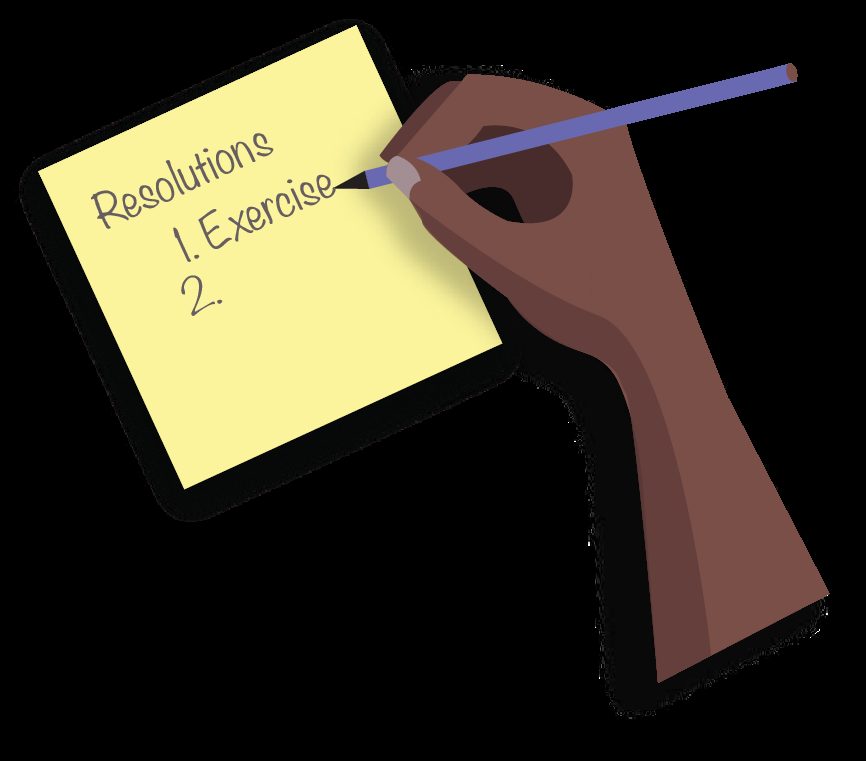Although Jan. 1 seems like the perfect day to start fresh, the expectation of instantaneous results that comes with New Year’s resolutions is not the most effective way to set goals.
For instance, reflect on a past resolution that you have set for yourself. Did you stick to it? If not, how long did it take for it to fail? Maybe you had no trouble keeping up with that resolution and it has become a permanent addition to your everyday lifestyle. But, more likely than not, you started out confidently for the first week and then lost interest which eventually resulted in failure.
Research conducted by Edward-Elmhurst Health Hospital found that 80% of people who make new year’s resolutions will have failed them by the second week of February. In fact, they found that most give up by Jan. 19, which has now been deemed quitter’s day; the basic existence of which proves that you cannot change your entire life overnight.
So, how do we set and keep productive resolutions?
“I’ve been thinking about cutting down on social media since school started, but I didn’t really know how I could.” junior Bianca Whatts said.
Like many others, Whatts was struggling to realistically achieve her desired goal without a plan in place. Setting big picture goals without first breaking them down into smaller, more manageable targets is often overlooked due to the mentality that immediate results will follow.
Starting with small changes in your daily life can lead to bigger changes long term. “You cannot put an emphasis on one day [New Year’s Day],” guidance counselor Rylan Smith said. “Take it one day at a time and realize that it takes time to make changes.”
Healthline reported that it takes anywhere from 18 to 254 days for the formation of a new habit and an average of 66 days for it to become automatic. If you look at gym memberships, for example, in the first two to three weeks of January, the gym is packed because everybody says ‘This year is going to be different.’” Smith said. “But after two to three weeks, we do not maintain that.”
Smith said that one of the biggest downfalls when setting resolutions is jumping in way too deep at the beginning without a plan.
One popular yet simple method to build habits is the 21/90 rule.
To do this, you must commit to a personal or professional goal for 21 consecutive days. After these three weeks have passed, the objective of the goal should have become a habit. Once the habit is established, it is continuously performed for another 90 days. If you can consecutively perform this routine for these 111 days, it will likely become a permanent lifestyle change.
According to Smith, you must realistically envision yourself achieving your goals before you create them since the root of the problem comes from the formation of resolutions themselves. “Focus on setting goals that make you a better person,” Smith said. “Identify unhealthy habits in your life and set goals that help you to form healthier habits in a way that is.”
In an interview with BBC, Per Carlbring at Stockholm University said that most people create two kinds of goals: avoidance goals and approach goals. An avoidance goal is something that involves giving up or quitting a habit like stopping eating junk food, stop staying up too late, etc. While an approach goal is adding a habit into your life like start reading more, or learning French.
“Instead of stopping things, you should start doing things,” Carlbring said in the BBC interview.
Another usual practice when setting goals for yourself is to write them down. Psychology professor Dr. Gail Matthews, at the Dominican University found that you are 42% more likely to achieve your goals if you put them on paper. However, failing or stumbling on a goal is okay. Social Science teacher Michael Hopkins, for example, set a new year’s resolution to cut down on his coffee consumption. And although he is proud of his overall success, he still faces struggles occasionally.
“I have moments of weakness, especially with the cold days that we have had in the past few weeks,” Hopkins said.
According to Carlbring, struggling is part of the process of long-term habit building. “If you face a setback, then you might think that you will never be able to achieve your goal,” Carlbring said. “But you can try to view it as a lesson to be learned.”
Rather than quitting for good, figuring out what works best for your own lifestyle using trial and error. Quitting could be a positive motivator but it also makes it easier to quit in the future. “But quitting can sometimes be the motivating factor for the next year,” Smith said. “If you didn’t reach your goal last year that could inspire a second try. Quitting could be a positive motivator but it also makes it easier to quit in the future.”
Everyone has different habits they want to build and different methods that work uniquely for you. “Celebrating your successes with your resolutions is key,” Smith said. “And when you are not successful, [reflect] on why that is and how you can change and improve.”
No matter what, if there is a new goal you really want to accomplish, why wait for the new year? Plan realistically and start while you are inspired.














